This post may include affiliate links; see our disclosure policy.
These Spanish recipes are some of the most classic this cuisine has to offer! Try traditional flavors from paella to tapas.

Looking for Spanish recipes? This cuisine holds a special place in our heart, after studying abroad there in college and traveling back to Spain recently. Spanish cuisine holds so many memories, like inhaling homemade paella with my host family for Sunday dinner, or slurping a cooling gazpacho in Andalucía with my 1 year old. Here’s a list of the top classic Spanish recipes to make at home: from main dishes to appetizers (tapas) to drinks. Whether you’re having a Spanish-themed dinner party or planning a tapas night, there’s something for everyone.
And now…15 classic Spanish recipes to try!
Here’s a stunning one pan dinner that’s made for celebrations: paella! This traditional Spanish rice dish has thousands of variations, but it’s always rice with an explosion of colorful toppings. This classic paella recipe is based on our travels through Spain. It stars saffron-scented rice, mixed colorful vegetables and shrimp, and it’s full of traditional flavor.
Here’s a traditional Spanish recipe that’s everywhere in country: Spanish tortilla! Tortilla española is a Spanish omelet made with eggs and sliced potatoes. You can find tortilla in almost every bar and restaurant. It’s a classic Spanish tapas recipe, sliced into wedges and often serve with a toothpick and a dab of aioli. It’s also often turned into a sandwich filling as a bocadillo de tortilla.
There’s not much better than a fruity glass of classic red sangria! Sangria is easily done wrong in America, loading it with sugar or ginger ale. But the classic Spanish way to make it is all about nuanced flavor. It’s bold, it’s fruity, and the perfect balance of dry and sweet. Here’s how to make red wine sangria like it’s made in Spain, featuring wine-soaked fruit, brandy, and a hint of orange liqueur.
Also try: White Sangria, Rose Sangria or 8 Easy Sangria Recipes
What’s more refreshing than a creamy, cool gazpacho? This Spanish soup is a cold tomato-based soup from the Andalusia region of Southern Spain. It’s made of raw, pureed vegetables and is now eaten around the world. The cool puree of tomato and cucumber against the zing of the sherry vinegar and rich olive oil is truly one of life’s great pleasures.
Pan con tomate translates to “bread with tomato,” a Spanish dish that consists of toasted bread topped with tomato pulp, garlic and olive oil. It’s served throughout Spain as tapas or a snack, and it’s especially common in Catalan cuisine where it’s called Pa amb tomàquet. Take one bite and it’s like ingesting the pure soul of a tomato: all its memories of growing plump in the summer sun.
Patatas bravas are a traditional Spanish tapas recipe. You’ll see them served at tapas bars all over Spain, and they're one of the most famous of all tapas. These "spicy potatoes" are crisp fried and serve with a tomato or mayo based sauce.
Cafe con leche (“coffee with milk” in Spanish) is a coffee drink made of strong coffee or espresso and steamed milk. The drink originated in Spain and is popular in Latin America, and uses equal parts coffee and milk. The intensely strong coffee is served in a glass and aggressively sweetened. You can find it at most cafes in country.
Here’s a tasty Spanish sauce recipe that every cook should have in their arsenal: Romesco Sauce! This bright red sauce is bursting with flavor: tangy, garlicky, savory, sweet, zingy and earthy all at once. There are so many facets to the flavor, it’s hard to comprehend it all in one bite! Serve it with grilled or roasted vegetables, fish, chicken, bread or really anything that needs a little sparkle.
The Kalimotxo is a drink that originated in Spain that’s equal parts red wine and cola. It originated in the 1970’s, apparently an invention of servers at a festival who were trying to cover up bad red wine. It’s now spread all over the world, especially popular in Eastern Europe as well as the Basque Country in Spain where it originated.
Try this classic Vegetarian Paella! Paella is a traditional Spanish dish that has loads of variations. Often it’s made with seafood, but we’ve tasted many delicious vegetable-based versions while traveling in Spain! The saffron-scented rice is loaded with a colorful assortment of vegetables, and it’s a true delight.
Pimientos de Padrón are small green peppers that come from Galicia in northwestern Spain. They're served blistered as a tapas recipe: tender, blackened and perfectly salted. They're similar to a shishito pepper, so if you can't find them you can substitute shishitos. (If you can find them, substitute Padrón peppers in the linked recipe.)
Salmorejo is a traditional cold Spanish soup that's similar to gazpacho, but it tastes distinctly different. It's made with ripe tomatoes, bread, garlic, sherry vinegar and olive oil, and often topped with a chopped boiled egg and Spanish ham, jamón Serrano. Via Eating European
Calamares Fritos are a traditional Spanish tapa recipe full of crunchy, salty flavor! The fried squid rings are served warm from the fryer, spritzed with lemon. You can find fried squid in the frozen section of the grocery store, or make it homemade with this recipe from Spanish Sabores.
Gambas al ajillo ("shrimp with garlic") is a traditional Spanish tapas recipe that's well loved in country. Large shrimp are marinated with salt and garlic before cooking them in olive oil. Try this recipe from Spanish Sabores.
Croquetas are beloved Spanish tapas recipe: small balls of a creamy filling with a crispy fried exterior. They're served warm from the fryer and are a staple in Spanish tapas bars and cafes. Ypu can find croquettes in the frozen section of the grocery store, or try this homemade croquetas recipe from Spanish Sabores.
Last but not least: end a meal with this Carajillo recipe! Carajillo is an after dinner cocktail of spiked hot coffee. It’s typical of Spain and some Latin American countries like Colombia, Cuba, and Mexico, and each country uses a different type of liquor. In Spain it’s served with brandy or Licor 43, a sweet Spanish liqueur.
Easy sides and appetizers to serve with Spanish food
How to round out a Spanish meal starring some of these Spanish recipes? Here are a few more items you can add to the meal to round it out:
- Accessorize with slices of Manchego cheese, a popular aged Spanish cheese
- Add marinated olives as an appetizer
- Mix up an Easy Arugula Salad or Citrus Salad, both starring tasty Mediterranean flavors
- Add bread: a crusty baguette with olive oil for dipping is perfect and classic
15 Classic Spanish Recipes: Paella & More!
Here’s how to make a paella recipe…the Spanish way! This stunning one pan dinner features shrimp, vegetables and all the authentic flavors of this traditional dish.
- Prep Time: 15 minutes
- Cook Time: 30 minutes
- Total Time: 45 minutes
- Yield: 4 1x
- Category: Main Dish
- Method: Stovetop
- Cuisine: Spanish
- Diet: Gluten Free
Ingredients
- 1 medium yellow onion
- 6 garlic cloves
- 2 to 3 roma or plum tomatoes (1 ½ cups finely chopped)
- ¼ cup olive oil, divided
- 1/2 pound shrimp, peel and deveined*
- 1 ½ teaspoons smoked paprika, divided
- ¼ teaspoon red pepper flakes
- 1 large pinch saffron
- 1 ½ teaspoons kosher salt, divided
- 3 cups seafood stock or vegetable stock
- 1 ½ cups short grain Bomba rice or arborio rice
- ¼ cup frozen peas, thawed under water
- ½ cup artichoke hearts, quartered
- 1 to 2 roasted red bell peppers, cut into strips
- Lemon wedges from ½ lemon
- Chopped parsley, for garnish
Instructions
- Prep the vegetables: Mince the onion. Mince the garlic. Finely chop the tomatoes, removing the cores but keeping the seeds with their juices.
- Measure out the ingredients: Measure out all the remaining ingredients before you start. The cooking process goes fast!
- Cook the shrimp: Dry the shrimp and add it to a bowl with ½ teaspoon smoked paprika and ¼ teaspoon kosher salt. In your largest skillet or a 4-serving paella pan, heat 1 tablespoon olive oil over medium heat. Add the shrimp and saute until it is just barely opaque, about 1 to 2 minutes per side. Remove the shrimp and set it aside.
- Cook the paella: In the same pan, heat 3 tablespoons olive oil on medium heat. Saute the onion and garlic until just translucent, about 3 minutes, stirring frequently. Add the chopped tomatoes, the remaining 1 teaspoon smoked paprika and red pepper flakes, and cook until the tomatoes have broken down and most of the liquid is evaporated, about 5 minutes. Stir in the stock, saffron and 1 ¼ teaspoon kosher salt. Sprinkle the rice evenly across the broth and tap the pan with a spoon to evenly spread the rice. Bring to a medium simmer and cook without stirring until liquid is absorbed, about 18 to 22 minutes (adjust the cook time as necessary if using a skillet).
- Adjust the heat as necessary: If your pan is large enough to span multiple burners on your stovetop, adjust the heat on each burner so you achieve a steady medium simmer. Rotate the pan every few minutes for an even cook.
- Add the artichoke, peas and roasted red pepper: When the top of the rice is beginning to show through the liquid (about 10 minutes into the cook time), press the artichokes and peas lightly into the rice. Add the strips of red pepper over the top.
- Assess whether the paella is done: In last few minutes, carefully watch the paella and rotate pan more frequently. As the paella finishes, you’ll see the steam start to slow down as the water cooks out. If desired, peek at the bottom of a pan by using a knife to scrape back the rice — you shouldn’t see any standing water. The sound will start to change from a simmer to a crackle. This indicates the crust is forming. Let the crackling continue for about 2 minutes before removing from the heat. If you smell any burning, remove immediately.
- Add the shrimp and serve: When the paella is done, add the shrimp to top of paella and squeeze the lemon wedges onto the top of the pan. Sprinkle with a pinch or two of kosher salt and add the parsley, if using. Serve with additional lemon wedges.
Notes
*Vegetarian and vegan variation: Go to Vegetarian Paella.












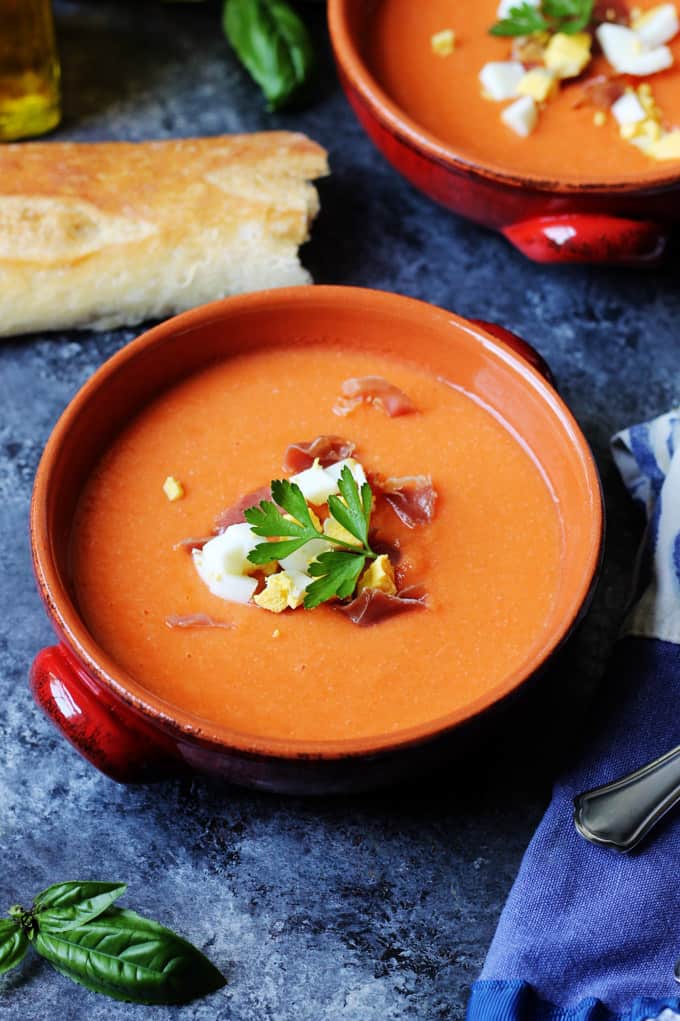
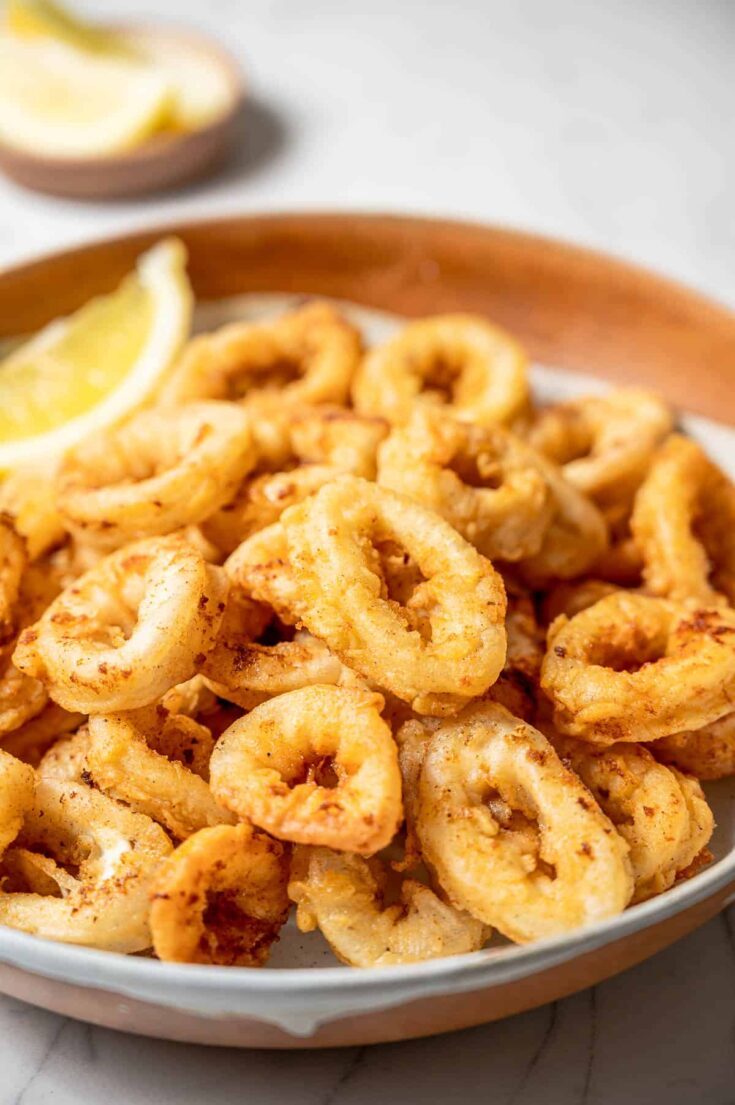
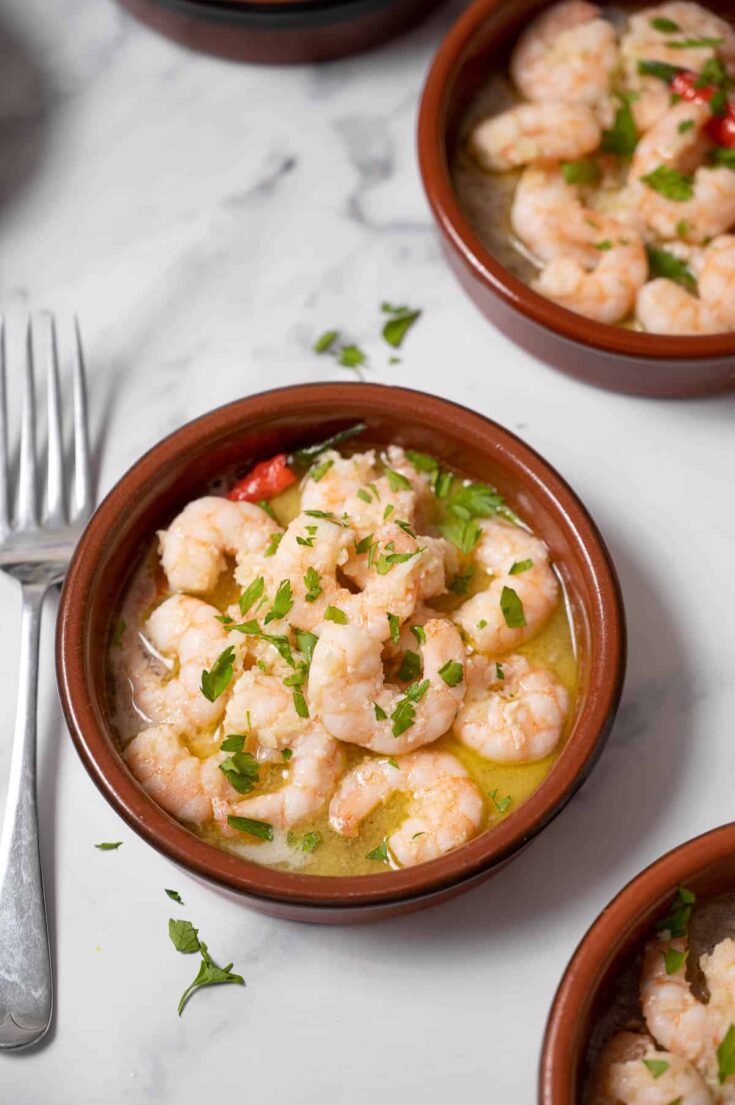



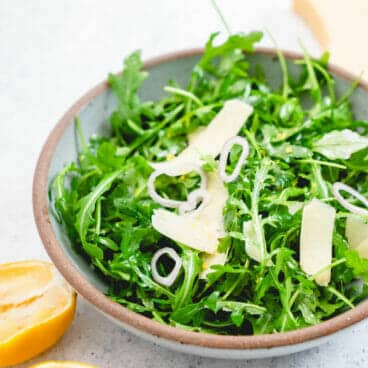


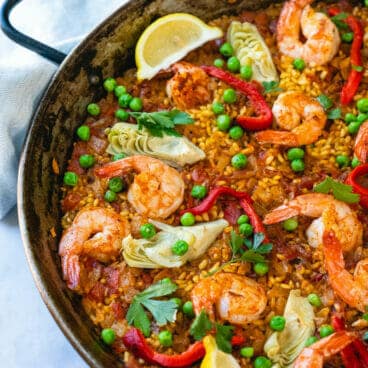


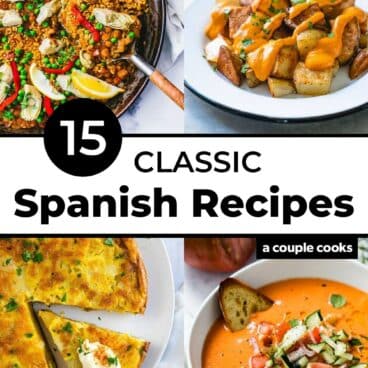
Let us know if you have any questions!